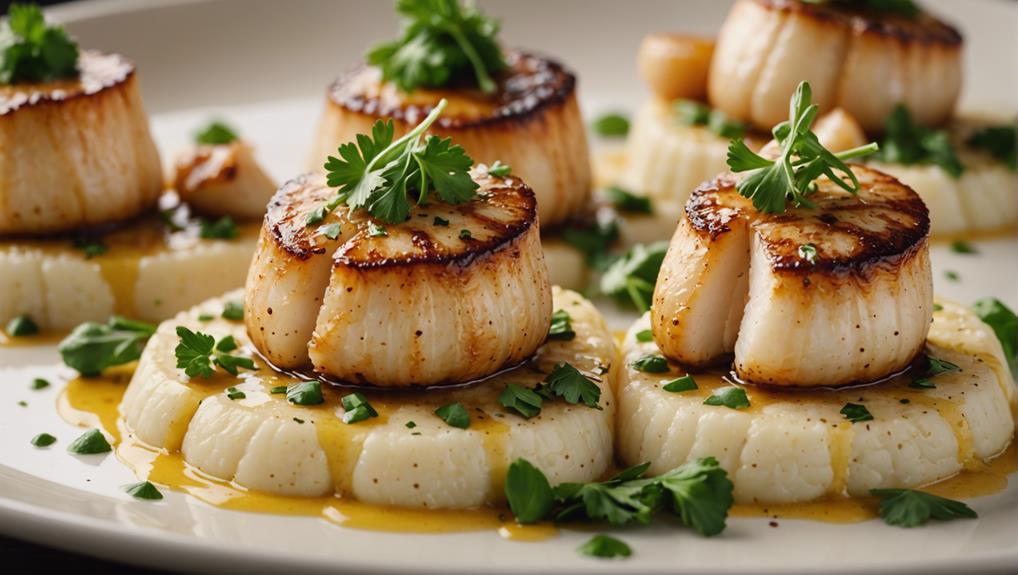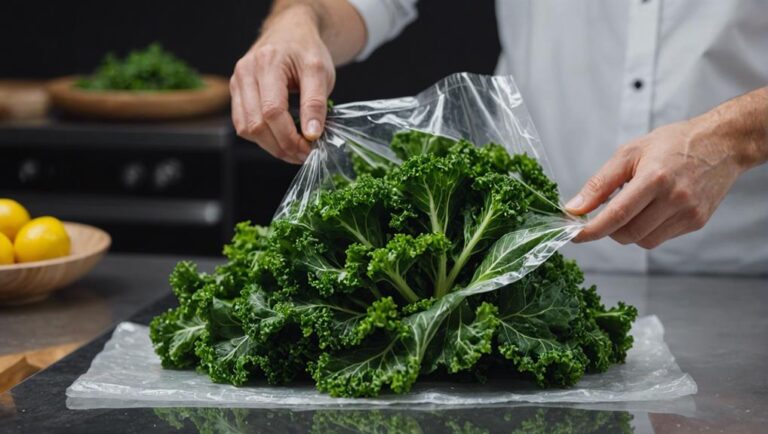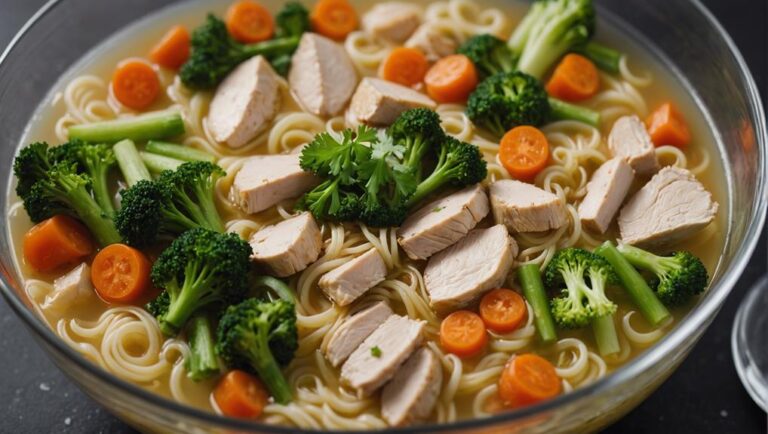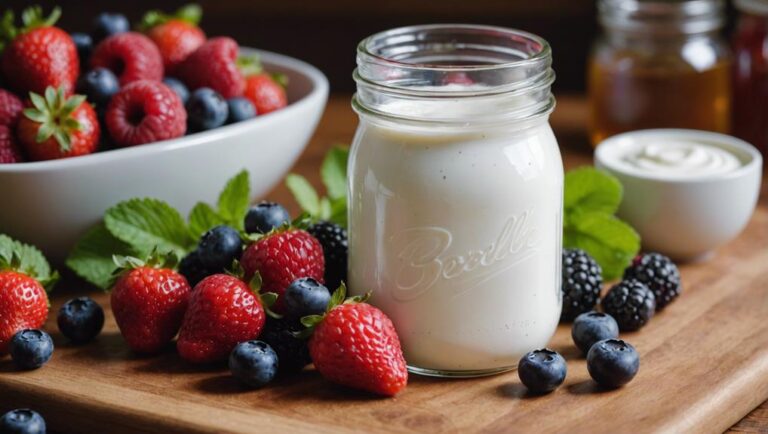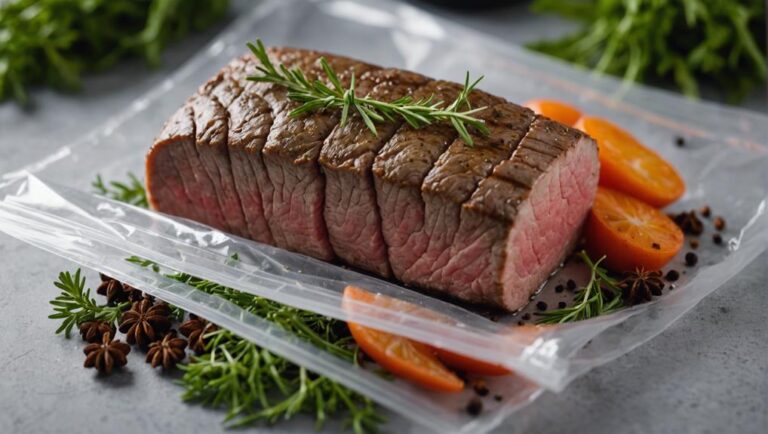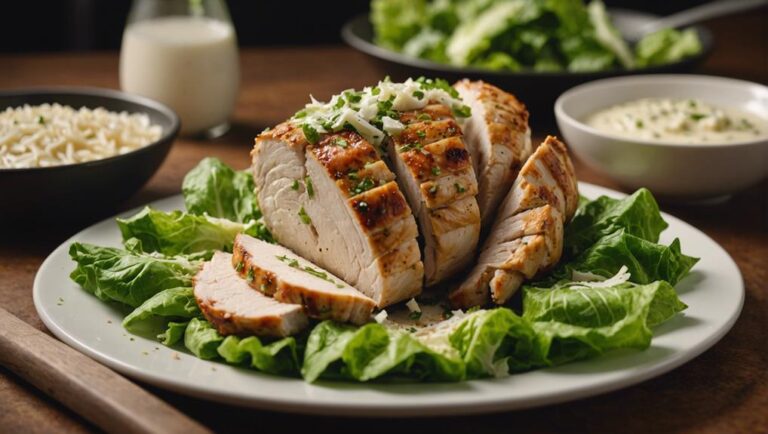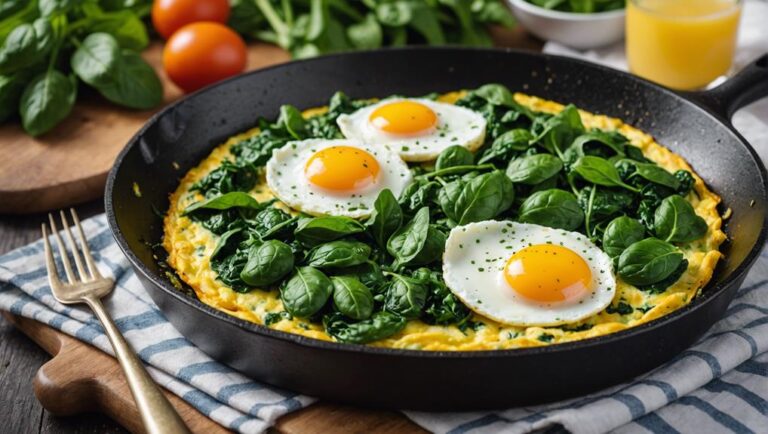Sous Vide Seared Scallops With Cauliflower Puree
Immerse yourself in the exquisite blend of succulent sous vide seared scallops and creamy cauliflower puree. The tender scallops, delicately cooked to perfection, harmonize with the velvety richness of the puree, creating an unforgettable culinary experience. The caramelized notes of the scallops interplay beautifully with the earthy undertones of the cauliflower, providing a symphony of flavors that will leave you craving more. The sweetness of the puree beautifully complements the richness of the scallops, while a hint of lemon adds a delightful contrast. Get ready for a dining journey that tantalizes your taste buds and leaves you longing for another bite.
What You Will Learn Here
- Sous vide cooking method ensures perfectly cooked scallops
- Creamy cauliflower puree balances scallop richness
- Lemon adds brightness to dish
- Contrasting flavors elevate overall taste
- Elegant presentation with vibrant colors
Scallop Harvesting Techniques
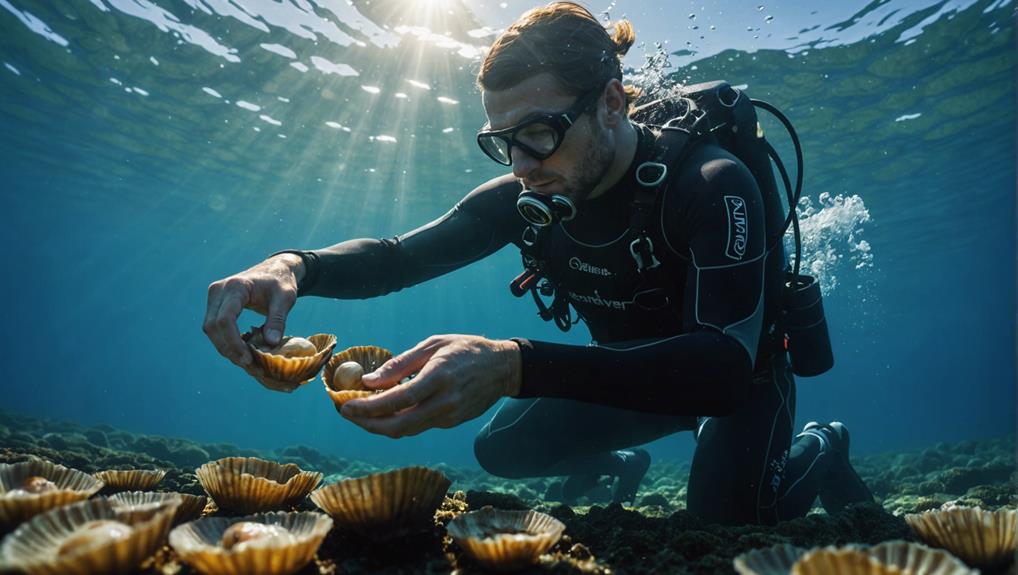
When it comes to harvesting scallops, the methods employed play an essential role in both the quality of the scallops and the impact on the marine environment.
Diving for scallops allows for a more selective and sustainable harvest, ensuring that only mature scallops are collected.
On the other hand, scallop dredging involves dragging a heavy metal frame along the seafloor, which can lead to habitat destruction and bycatch issues.
Sustainable scallop farming presents a promising alternative, offering a controlled environment that reduces pressure on wild scallop populations.
Diving for Scallops
For a scallop diver, the underwater world transforms into a domain of precision, skill, and patience as they navigate the depths in pursuit of these prized shellfish. The art of scallop diving involves a delicate balance of technique and respect for the marine environment. Divers equipped with modern gear can now explore the seabed with enhanced safety and efficiency, contributing to sustainable seafood practices and scallop conservation efforts. The advancements in diving equipment have not only made scallop harvesting more accessible but have also aided in minimizing environmental impact. By embracing these innovations, divers can play an essential role in ensuring the longevity of scallop populations for future generations.
| Diving Equipment Advancements | Sustainable Seafood Practices | Scallops Culinary Trends | Scallops Conservation Efforts |
|---|---|---|---|
| Enhanced safety features | Preservation of marine ecosystems | Popular in fine dining | Protecting scallop habitats |
Scallop Dredging Methods
Scallop dredging methods employ specialized equipment to extract these delectable shellfish from the ocean floor efficiently. This technique involves dragging a heavy metal frame with chain bags or nets across the seabed, collecting scallops in its path. While productive, dredging can harm the seabed habitat.
When cooking scallops, searing them in a hot pan or sous vide are popular techniques that preserve their delicate flavor and texture. Pairing scallops with a crisp white wine enhances their natural sweetness, creating a delightful culinary experience.
Sustainable scallop harvesting practices are vital to protect marine ecosystems and ensure the longevity of this seafood favorite. When presenting scallops, simplicity often reigns supreme, allowing the natural beauty of the dish to shine through.
Sustainable Scallop Farming
Amidst the vast ocean expanse, sustainable scallop farming emerges as a pivotal practice, revolutionizing traditional harvesting techniques. Aquaculture sustainability lies at the core of this method, aiming to reduce the environmental impact of scallop cultivation.
Unlike traditional scallop dredging, which can harm marine ecosystems, sustainable farming practices prioritize the long-term health of the ocean. By cultivating scallops in controlled environments, farmers can regulate water quality, feed, and growth conditions, ensuring a more sustainable harvest.
This approach not only benefits the scallop population but also contributes to the overall health of the marine ecosystem. Embracing sustainable scallop farming techniques is essential for safeguarding our oceans and ensuring a bountiful harvest for generations to come.
Scallop-Enhancing Seasoning Mix
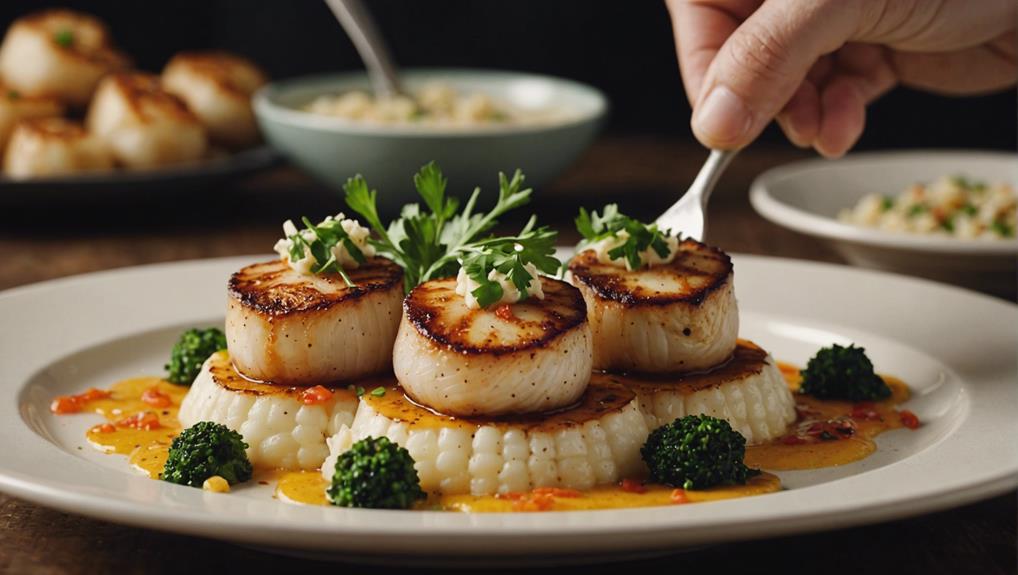
Enhance the natural flavors of your scallops by incorporating a carefully crafted seasoning mix that complements their delicate taste. When preparing your scallops, consider using a blend of flavorful rubs and umami seasonings to elevate their inherent sweetness and brininess. Here are three essential elements to include in your scallop-enhancing seasoning mix:
- Smoked Paprika: Add a touch of smokiness to your scallops with smoked paprika. This spice not only imparts a subtle smoky flavor but also enhances the overall richness of the dish.
- Lemon Zest: Brighten up the flavors of your scallops with some fresh lemon zest. The citrusy notes will provide an invigorating contrast to the sweet and savory profile of the scallops.
- Garlic Powder: For a hint of earthiness and depth, sprinkle some garlic powder into your seasoning mix. The aromatic quality of garlic will complement the natural sweetness of the scallops, creating a well-rounded flavor profile that's sure to impress your taste buds.
Scallop-Centric Culinary Creations
When it comes to scallop-centric culinary creations, the possibilities are endless.
Imagine the invigorating tang of Scallop Ceviche with a zesty citrus marinade, or the delightful crunch of Seared Scallop Tacos bursting with flavor.
And let's not forget the luxurious indulgence of Sous Vide Scallops with truffle butter – each dish a masterpiece in its own right.
Scallop Ceviche With Citrus Marinade
In this scallop ceviche with citrus marinade, the zesty flavors of the citrus infuse the delicate scallops, creating an invigorating and lively dish that highlights the natural sweetness of the seafood.
- Scallop Ceviche Variations: Experiment with different citrus fruits like lime, lemon, or orange to find the perfect balance of acidity for your ceviche.
- Presentation: Serve the scallop ceviche in chilled martini glasses for an elegant touch, garnished with fresh herbs or edible flowers for a pop of color.
- Citrus Marinade Pairings: Pair your scallop ceviche with a crisp Sauvignon Blanc or a light-bodied Pinot Grigio to complement the citrus notes and enhance the overall invigorating experience.
This dish is perfect for a light and vibrant appetizer that will awaken your taste buds with each citrus-infused bite.
Seared Scallop Tacos Recipe
Seared to perfection and bursting with flavor, these scallop tacos redefine the taco experience with their scallop-centric culinary flair.
- Grilled scallop skewers: Imagine succulent scallops, lightly charred and infused with smoky goodness, nestled in warm tortillas with vibrant toppings.
- Scallops in pasta: Delicate scallops delicately tossed with al dente pasta, coated in a velvety sauce that hugs each noodle and scallop, creating a harmonious blend of flavors.
- Seared scallop tacos: Tender scallops seared to a golden brown, placed atop a bed of crunchy slaw, drizzled with a zesty sauce, all hugged by a soft tortilla – a symphony of textures and tastes in every bite.
These scallop tacos are a celebration of seafood excellence, a fusion of flavors that will leave your taste buds dancing with delight.
Sous Vide Scallops With Truffle Butter
Indulge in the exquisite flavors of sous vide scallops elevated with luxurious truffle butter, a culinary masterpiece that will elevate your dining experience to new heights.
When it comes to creating a memorable dish with sous vide scallops and truffle butter, consider the following:
- Truffle Pairing Ideas:
- Pair your scallops with a truffle-infused risotto for a rich and invigorating combination.
- Try serving the scallops over a bed of creamy truffle mashed potatoes for a decadent twist.
- Accompany the scallops with a truffle vinaigrette salad for a revitalizing contrast to the buttery richness.
- Recipe Variations:
- Experiment with adding a touch of truffle oil to the butter for an intensified truffle flavor.
- Incorporate finely chopped truffle pieces into the butter for added texture and aroma.
- Create a truffle butter sauce by deglazing the pan with white wine and finishing with a dollop of truffle butter.
Searing Scallops to Perfection
When it comes to searing scallops, achieving the perfect sear is all about mastering the art of caramelization.
Controlling the temperature of your pan is essential in creating that golden crust without overcooking the delicate scallop.
Investing in quality searing equipment can make a noticeable difference in the final texture and flavor of your scallops.
Achieving the Perfect Sear
To achieve the perfect sear on scallops, the key lies in properly preheating your skillet and ensuring your scallops are completely dry before cooking. When it comes to searing techniques, a hot skillet is your best friend. Heat it up until it's smoking hot, then add a high smoke point oil like grapeseed or avocado oil.
Gently place your dry scallops in the pan, making sure not to overcrowd them. Let them cook undisturbed for about 1-2 minutes per side until they develop a beautiful golden crust. This quick sear locks in the juices, creating a delightful contrast to the tender interior.
Experiment with different seasonings to elevate the flavor profiles and consider elegant presentation tips for plating ideas that will impress your guests.
Temperature Control Tips
For precise temperature control when searing scallops to perfection, monitor the heat of your skillet closely to achieve the ideal searing temperature. Cooking hacks can make a significant difference in the outcome.
Guarantee your skillet is preheated over medium-high heat before adding the scallops to achieve that beautiful golden crust. Use a high smoke-point oil like grapeseed or avocado oil to prevent burning and impart a delicate flavor. When the scallops hit the pan, they should sizzle gently; if they don't, your pan may not be hot enough.
Equipment for Searing
To achieve the ideal sear on your scallops, selecting the right equipment is essential for excellent results. When it comes to searing techniques, a cast-iron skillet or stainless steel pan are the best tools for the job. These materials distribute heat evenly, helping you achieve that perfect golden crust on your scallops.
Make sure your pan is preheated to a high temperature before adding the scallops to guarantee a quick, crispy sear without overcooking the delicate flesh. A pair of sturdy tongs will allow you to easily flip the scallops and sear them on both sides.
Final Thoughts
In conclusion, the delicate balance of flavors in this dish is sure to impress even the most discerning of palates. The succulent sous vide seared scallops paired with the creamy cauliflower puree create a harmonious blend that dances on your taste buds. The marriage of the sweet, caramelized notes from searing and the earthy undertones of the cauliflower is a match made in culinary heaven.
When it comes to flavor pairings, the richness of the scallops is beautifully complemented by the subtle sweetness of the cauliflower puree. The slight acidity from a squeeze of lemon cuts through the richness, adding a revitalizing twist to each bite. This dish showcases how contrasting flavors can work together to elevate a dish to a gourmet level.
In terms of presentation techniques, the vibrant colors of the seared scallops against the creamy white puree create a visually stunning plate. The sear marks on the scallops add a touch of elegance, making this dish not only a delight for the taste buds but also a feast for the eyes. The final touch of fresh herbs or microgreens on top adds a pop of color and freshness that ties the whole dish together beautifully.
Frequently Asked Questions
Can Frozen Scallops Be Used for This Recipe?
Yes, frozen scallops can be used, but fresh ones tend to yield better results. When considering cooking techniques like sous vide, fresh scallops often have a superior texture and flavor profile compared to their frozen counterparts.
How Can I Ensure the Scallops Are Not Overcooked?
To guarantee scallops aren't overcooked, sous vide method with precise temperature control is key. After, sear for caramelization. This combo guarantees perfectly cooked scallops every time, tender on the inside with a crispy outer layer.
Is It Necessary to Use a Food Processor for the Cauliflower Puree?
You don't need a food processor for cauliflower puree; a blender alternative or hand mashing technique works well. It's all about personal preference and the texture you desire. Experiment and find what suits your taste best.
Can I Substitute Cauliflower With Another Vegetable for the Puree?
Yes, you can swap cauliflower for other veggies, like sweet potato or parsnips, to create unique flavor variations. Experimenting with different substitute options not only adds variety but also allows you to tailor the puree to your taste preferences.
What Wine Pairings Would Complement This Dish Best?
For the perfect wine pairings, consider a crisp Chardonnay or a light Pinot Noir. Chardonnay's buttery notes complement the scallops, while Pinot Noir's fruity flavors balance the cauliflower puree. Experiment to find your ideal match.
Conclusion
Indulge in the luxurious combination of tender sous vide scallops and velvety cauliflower puree for a truly exquisite dining experience.
The delicate flavors of the scallops are enhanced by a perfectly seared crust, creating a harmonious balance of textures and tastes.
This dish is a true culinary masterpiece, showcasing the artistry and precision of sous vide cooking.
Treat yourself to this decadent meal and elevate your dining experience to new heights.
